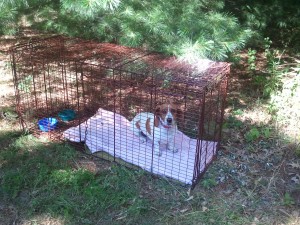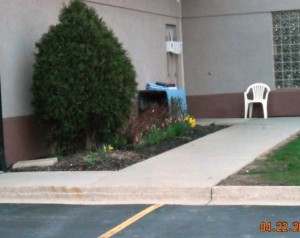 Choose the spot wisely, and you’ll have a better chance of successfully trapping your shy lost dog. Choose it poorly and it can be an exercise in futility. First and foremost, you MUST have the landowner’s permission to set a trap on his property. If you don’t, you are setting yourself up for a whole lot of legal trouble. Trapping can be risky to both wildlife, pets and people. Landowners need to be aware of their potential liability when they allow you to set a trap on their property.
Choose the spot wisely, and you’ll have a better chance of successfully trapping your shy lost dog. Choose it poorly and it can be an exercise in futility. First and foremost, you MUST have the landowner’s permission to set a trap on his property. If you don’t, you are setting yourself up for a whole lot of legal trouble. Trapping can be risky to both wildlife, pets and people. Landowners need to be aware of their potential liability when they allow you to set a trap on their property.
Because of the liability, there are several places where you are unlikely to get permission. So be forewarned, you may want to choose a different spot. The places you are unlikely to get permission are:
- Playgrounds
- Public parks and campgrounds
- Churches
- Schools
- Government buildings
- Large corporations
We have the most success getting permission from a private homeowner, farmer or small business owner. Call them up and arrange to meet with them; explain your situation and show them a picture of your dog. Many private property owners will sympathize with you and give you the permission you need to set up a feeding station and a trap. Make sure they understand that you may be visiting at odd hours, several times a day. Otherwise, you may wear out your welcome quickly. An ideal situation, is when you can get easy access by a path or side road. Then you won’t have to be driving past their house at all hours of the day and night.
Now, where to actually put it? The site needs to be level and cleared of any debris that might stick up through the bottom of the trap and interfere with the trip plate. If it is a two door trap, you will need to have easy access to both sides. You don’t want to have to keep pulling it out and moving it to rebait it.
Make the trap “part of the landscape”. Look around and think like a shy, lost dog. They usually like to slink along the side of a building or a tree line. Positioning your trap along a building, fence line or tree line is usually a wise choice.
You don’t want it anywhere that the public can see it or may stumble across it. In fact, you NEVER want to disclose a trap location or a feeding station publicly – never on a Facebook page, in a blog, or to the media. Keep the location confidential because wanna-be heroes, reward seekers, and curious people can derail your plans very fast. Then you will be picking up and starting all over again. It is very frustrating and easier to avoid problems by keeping the details confidential.
Choose a spot where you can see the trap from a distance, possibly with binoculars. You can put a small square (about 4″) of white material on the door of the trap to help you determine from a distance if it has been tripped. The less you disturb the trap location, the better. Your shy, lost dog needs the confidence that he can visit the site, eat and relax without being disturbed. Part 12
Our tips, ideas and articles are based on information gathered from over thousands of lost dog recoveries. Any advice or suggestions made by Lost Dogs of Wisconsin/Lost Dogs Illinois is not paid-for professional advice and should be taken at owner’s discretion.

